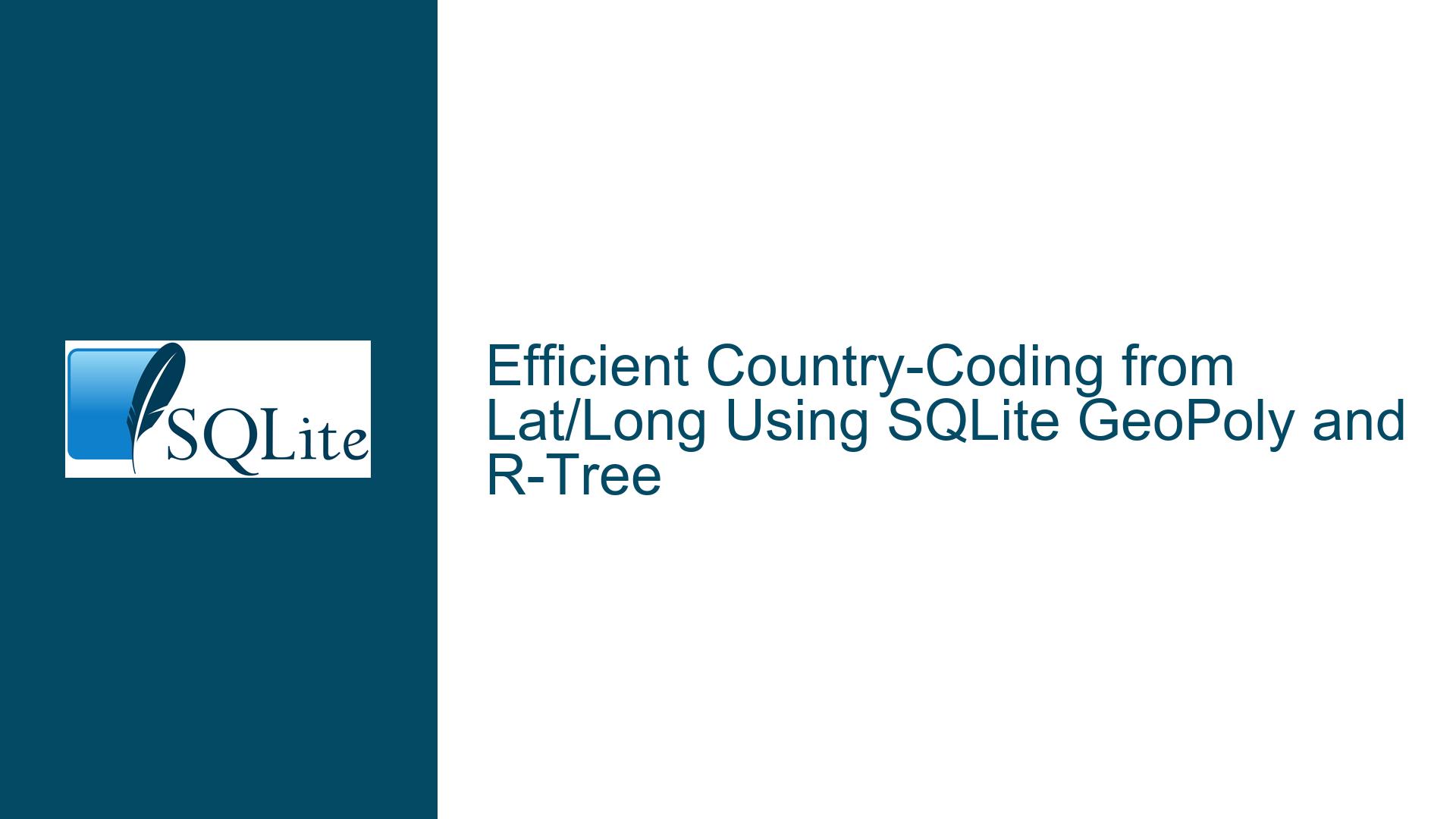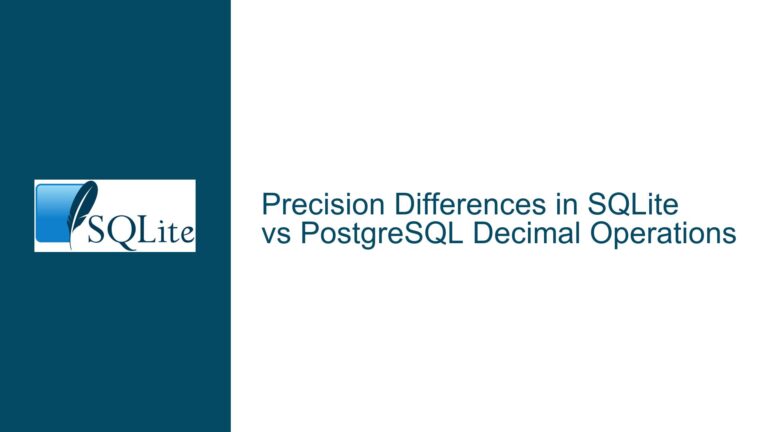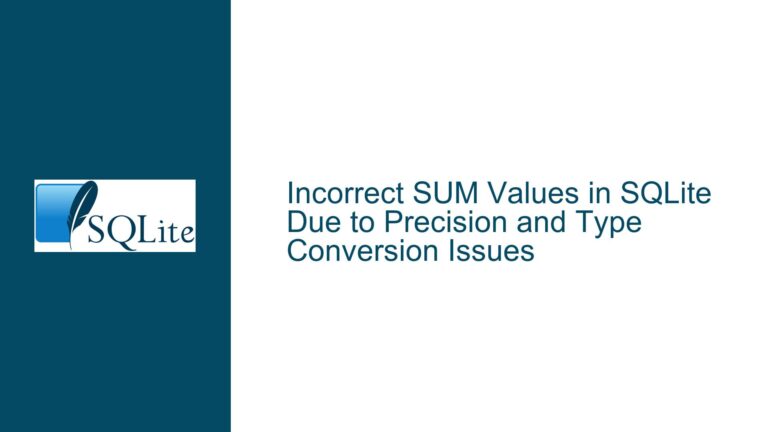Efficient Country-Coding from Lat/Long Using SQLite GeoPoly and R-Tree
Geo-Spatial Filtering of Latitude/Longitude Data by Country Boundaries
Geo-spatial filtering of latitude and longitude data by country boundaries is a common requirement for applications that deal with geographical data. The process involves determining whether a given point (represented by latitude and longitude coordinates) lies within the boundaries of a specific country. This task can be complex due to the irregular shapes of country boundaries, which often include concave and convex regions, islands, and enclaves. SQLite, with its GeoPoly and R-Tree extensions, provides a robust framework for handling such geo-spatial queries efficiently.
The GeoPoly extension in SQLite allows for the representation and manipulation of polygonal regions, which can be used to model country boundaries. The R-Tree extension, on the other hand, is a spatial index that can be used to quickly filter out points that are not within the bounding box of a country, thereby reducing the number of points that need to be checked against the actual polygonal boundary. Together, these extensions enable efficient geo-spatial queries, but there are several nuances and potential pitfalls that need to be considered.
One of the primary challenges is the acquisition of accurate and detailed country boundary data. Country boundaries can be highly irregular, and the level of detail required can vary depending on the application. For example, some applications may require high-resolution boundaries that include small islands and enclaves, while others may be satisfied with lower-resolution boundaries that approximate the shape of the country. Additionally, the accuracy of the boundary data can be affected by factors such as border disputes and changes in political boundaries over time.
Another challenge is the efficient implementation of the geo-spatial queries. While the R-Tree index can be used to quickly filter out points that are not within the bounding box of a country, the actual determination of whether a point lies within the polygonal boundary of a country can be computationally expensive. This is especially true for countries with complex boundaries that include many vertices. Therefore, it is important to optimize the query process to ensure that it performs well even with large datasets.
Challenges with Irregular Country Boundaries and R-Tree Indexing
The irregular shapes of country boundaries pose significant challenges for geo-spatial filtering. Unlike simple geometric shapes such as rectangles or circles, country boundaries can have complex geometries that include concave and convex regions, islands, and enclaves. This complexity makes it difficult to determine whether a given point lies within the boundary of a country using simple geometric algorithms.
The R-Tree index in SQLite is a spatial index that can be used to quickly filter out points that are not within the bounding box of a country. The bounding box is the smallest rectangle that completely encloses the country boundary. By using the R-Tree index, we can quickly eliminate points that are outside the bounding box, thereby reducing the number of points that need to be checked against the actual polygonal boundary.
However, the R-Tree index alone is not sufficient to determine whether a point lies within the polygonal boundary of a country. The R-Tree index only provides a rough filter based on the bounding box, and a more detailed check is required to determine the exact location of the point relative to the boundary. This detailed check can be computationally expensive, especially for countries with complex boundaries that include many vertices.
One approach to optimizing this process is to use a multi-step filtering strategy. In the first step, the R-Tree index is used to quickly filter out points that are not within the bounding box of any country. In the second step, a convex hull is used to further filter out points that are not within the general shape of the country. The convex hull is a polygon that completely encloses the country boundary and has no concave regions. By using the convex hull, we can eliminate points that are outside the general shape of the country, thereby reducing the number of points that need to be checked against the actual polygonal boundary.
In the final step, the actual polygonal boundary is used to determine whether the point lies within the country. This step involves checking the parity of the number of intersections between a ray drawn from the point to a known point outside the country and the boundary of the country. If the number of intersections is even, the point is outside the country; if it is odd, the point is inside the country. This algorithm, known as the ray casting algorithm, is computationally expensive but provides an accurate determination of the point’s location relative to the boundary.
Optimizing Geo-Spatial Queries with GeoPoly and R-Tree in SQLite
To optimize geo-spatial queries using SQLite’s GeoPoly and R-Tree extensions, it is important to follow a structured approach that includes data preparation, indexing, and query optimization. The following steps outline a best-practice approach to implementing efficient geo-spatial queries for country-coding based on latitude and longitude data.
Data Preparation: The first step in optimizing geo-spatial queries is to prepare the country boundary data. This involves acquiring accurate and detailed boundary data in a format that can be used with SQLite’s GeoPoly extension. GeoJSON is a commonly used format for representing geographical features, and there are many sources of GeoJSON data available online. Once the boundary data has been acquired, it should be imported into SQLite using the GeoPoly extension. This involves creating a table to store the polygonal boundaries and inserting the boundary data into the table.
Indexing: The next step is to create an R-Tree index on the bounding boxes of the country boundaries. The R-Tree index will be used to quickly filter out points that are not within the bounding box of any country. To create the R-Tree index, a virtual table should be created using the R-Tree extension. The virtual table should include columns for the minimum and maximum latitude and longitude values of the bounding box. Once the virtual table has been created, the bounding box data should be inserted into the table.
Query Optimization: The final step is to optimize the geo-spatial query itself. The query should be structured to take advantage of the R-Tree index and the convex hull filter. The query should first use the R-Tree index to filter out points that are not within the bounding box of any country. Next, the query should use the convex hull to further filter out points that are not within the general shape of the country. Finally, the query should use the actual polygonal boundary to determine whether the point lies within the country.
To illustrate this process, consider the following example query:
-- Create a table to store the polygonal boundaries
CREATE TABLE country_boundaries (
id INTEGER PRIMARY KEY,
name TEXT,
boundary GEOpoly
);
-- Create an R-Tree index on the bounding boxes
CREATE VIRTUAL TABLE country_rtree USING rtree(
id,
min_lat,
max_lat,
min_lon,
max_lon
);
-- Insert the bounding box data into the R-Tree index
INSERT INTO country_rtree
SELECT id, MIN(lat), MAX(lat), MIN(lon), MAX(lon)
FROM country_boundaries;
-- Query to find the country for a given latitude and longitude
SELECT name
FROM country_boundaries
WHERE id IN (
SELECT id
FROM country_rtree
WHERE min_lat <= ? AND max_lat >= ? AND min_lon <= ? AND max_lon >= ?
)
AND geopoly_contains_point(boundary, ?, ?);
In this example, the country_boundaries table stores the polygonal boundaries of the countries, and the country_rtree table stores the bounding boxes of the countries. The query first uses the R-Tree index to filter out points that are not within the bounding box of any country. Next, the query uses the geopoly_contains_point function to determine whether the point lies within the polygonal boundary of the country.
Performance Considerations: When implementing geo-spatial queries, it is important to consider the performance implications of the query. The R-Tree index provides a significant performance boost by reducing the number of points that need to be checked against the actual polygonal boundary. However, the performance of the query can still be affected by factors such as the complexity of the country boundaries and the size of the dataset.
To further optimize the query, consider the following best practices:
Use Convex Hulls: As mentioned earlier, using a convex hull can help reduce the number of points that need to be checked against the actual polygonal boundary. This can provide a significant performance boost, especially for countries with complex boundaries.
Batch Processing: If you are processing a large number of points, consider batching the points and processing them in chunks. This can help reduce the memory usage and improve the overall performance of the query.
Caching: If the country boundary data does not change frequently, consider caching the results of the geo-spatial queries. This can help reduce the computational overhead of the queries and improve the response time.
Parallel Processing: If you have a multi-core processor, consider parallelizing the geo-spatial queries. This can help distribute the computational load across multiple cores and improve the overall performance of the queries.
Handling Edge Cases: Geo-spatial queries can be affected by edge cases such as points that lie on the boundary of a country or points that are near the boundary. To handle these edge cases, consider the following approaches:
Borderline Points: For points that lie on the boundary of a country, consider returning both countries as potential matches. This can be done by modifying the query to include a buffer zone around the boundary.
Nearby Countries: For points that are near the boundary of a country, consider returning nearby countries as potential matches. This can be done by expanding the bounding box of the country and checking for overlapping polygons.
Enclaves and Exclaves: Some countries have enclaves or exclaves that are completely surrounded by another country. To handle these cases, consider using a multi-step filtering process that first checks for the main country and then checks for any enclaves or exclaves.
Data Sources and Preprocessing: The quality of the geo-spatial query results depends heavily on the quality of the country boundary data. Therefore, it is important to use reliable and accurate data sources. Some commonly used data sources for country boundaries include:
Natural Earth: Natural Earth provides high-quality vector data for countries, including boundaries, coastlines, and other geographical features. The data is available in various formats, including Shapefile and GeoJSON.
GeoNames: GeoNames provides a comprehensive database of geographical names and features, including country boundaries. The data is available in various formats, including CSV and GeoJSON.
OpenStreetMap: OpenStreetMap provides a collaborative map of the world, including detailed country boundaries. The data is available in various formats, including XML and GeoJSON.
Once the boundary data has been acquired, it may need to be preprocessed before it can be used with SQLite’s GeoPoly extension. This preprocessing may include converting the data to GeoJSON format, simplifying the polygons to reduce the number of vertices, and removing any holes or overlapping regions.
Conclusion: Geo-spatial filtering of latitude and longitude data by country boundaries is a complex but essential task for many applications. SQLite’s GeoPoly and R-Tree extensions provide a powerful framework for implementing efficient geo-spatial queries. By following a structured approach that includes data preparation, indexing, and query optimization, it is possible to achieve high-performance geo-spatial queries that can handle the complexities of real-world country boundaries. Additionally, by considering edge cases and using reliable data sources, it is possible to ensure the accuracy and reliability of the geo-spatial query results.






